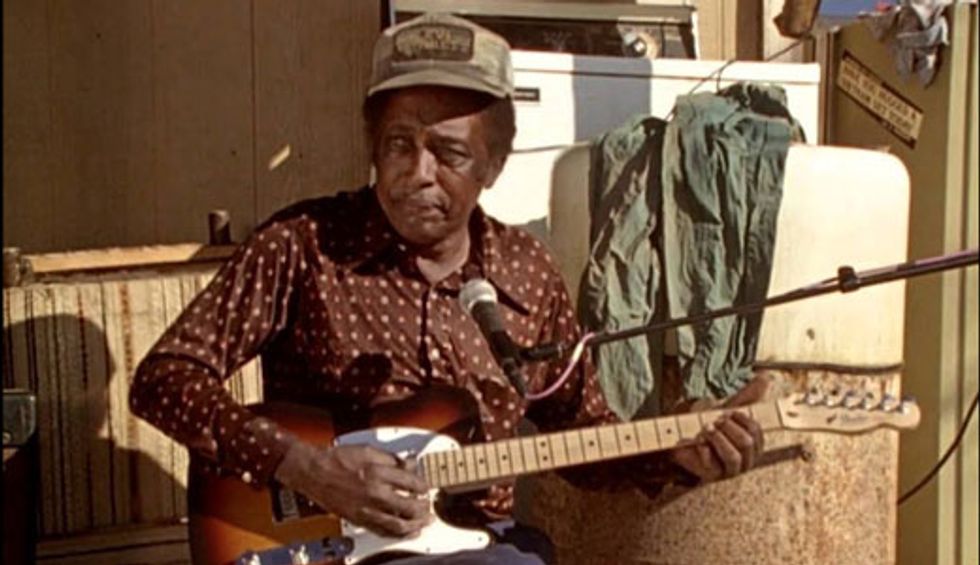Chops: Intermediate
Theory: Intermediate
Lesson Overview:
• Cultivate an appreciation for this influential country blues subgenre.
• Develop the ability to simultaneously play rhythm and melody with and without slide.
• Expand your sound with alternate tunings. Click here to download a printable PDF of this lesson's notation.
The area referred to as the North Mississippi hill country, which lies south of Memphis and east of the Delta, has produced some of the deepest blues ever heard. This region has a style and tradition all its own, characterized by hypnotic guitar riffs, driving rhythms, and howling vocals. In many cases, there are also open song structures that allow greater freedom of expression than the familiar 12-bar progression.
Due to its freer song forms and trance-inducing grooves, hill country blues may be considered by some to be a fringe element in the canon. However, it remains a vital and evolving art form that is beloved by both a local and worldwide audience. This is largely due to its raw immediacy and the highly personal styles of the genre’s most charismatic performers.
This music, and the culture it expressed, was brought to a wider audience in the ’90s by Oxford’s Fat Possum Records. The performers on many of these albums had been active for decades playing their music at juke joints, house parties, picnics, and on porches. Musicologists have traced this style back to pre-Civil War fife-and-drum traditions and the polyrhythms of West Africa.
Fat Possum infused the timeless hill country sound with a more contemporary aesthetic, using distorted electric guitars and transparent production to drop the listener into the middle of the music. Listening to the classic records of the genre will connect you to the past, present, and future in an instant. It will transport you into the heart of the human experience in a way that only the blues of the hill country can. It will get your feet tapping, your head nodding, and will bring a smile to your face with a powerful beat that runs through the center of the sound like the Mississippi river.
To cover the breadth and depth of hill country guitar could easily fill an entire book, so we’ll narrow our focus to three central artists for this lesson.
R.L. Burnside was perhaps the most charismatic of the Fat Possum roster and one of the first to gain wider attention due to his collaboration with Jon Spencer.
Burnside’s mentor, “Mississippi” Fred McDowell, with his percussive and stinging slide guitar, is known as an early and influential figure. McDowell was also a mentor to Bonnie Raitt.
Robert Belfour’s powerful monotonic bass lines, sweet melodies, and mournful vocals is a Mississippi favorite. Belfour’s recordings of regional standards “Done Got Old” and “Mattie” are exemplary of the style, but he also penned a number of hill country classics, including “Pushing My Luck.”
To play these tunes authentically, you’ll need to use a fingerpicking technique that assigns the thumb to the low strings and one or two fingers to the high strings. Many players from Mississippi only use the thumb and index finger, but using the thumb plus two fingers for the melody can divide the workflow more efficiently. Experiment to find what’s best for you.
In Ex. 1 we get a feel for one of Burnside’s classic grooves, which he performed and recorded with subtle variations over the decades of his musical life. Left-hand damping throughout will give you the percussive sound that’s essential to the vibe.
Click here for Ex. 1
For Belfour’s hard-driving boogie, use the thumb to cover the bass line and then brush up with
the index to give it momentum (Ex. 2). Palm muting with the right hand will give it a more percussive feel, but many Mississippi players do not mute the low strings, which results in a fuller low end. These next few examples are in the “Spanish” variation of open G (D–G–D–G–B–D), but down a half-step (C#–F#–C#–F#–A#–C#).
Click here for Ex. 2
We’re sticking with the same general feel as the previous example, but this time I’m adding an extra melody on top (Ex. 3).
Click here for Ex. 3
The Belfour-style variation in Ex. 4 is a go-to riff that pops up in many of his songs.
Click here for Ex. 4
In Ex. 5, I put all the Belfour-isms together and bump up the tempo a bit.
Click here for Ex. 5
Let’s move on to the great Fred McDowell with Ex. 6. This version of “You Gotta Move” is a traditional African American spiritual that became widely associated with McDowell after the Rolling Stones covered it on Sticky Fingers. In this arrangement, we will focus on the slide melody with sparse low-end accompaniment. Start with the melody and add the low notes once you feel ready. Playing this tune with the thumb, index, and middle fingers can be highly beneficial. For this one, tune your guitar to open D (D–A–D–F#–A–D).
Click here for Ex. 6
We’ve only begun to scratch the surface of Hill Country blues. As with all the great blues traditions, it takes a lifetime of work and enjoyment to understand and master the style. The open song structures of the hill country can make for an engaging listen, but a challenging study, so be patient and stick with it. Learning to play in this style will deepen your intuition and groove in a way that is infinitely rewarding and fun. The music of the North Mississippi hill country has been known to forever change and inspire the lives of musicians all around the globe.











![Rig Rundown: Russian Circles’ Mike Sullivan [2025]](https://www.premierguitar.com/media-library/youtube.jpg?id=62303631&width=1245&height=700&quality=70&coordinates=0%2C0%2C0%2C0)







